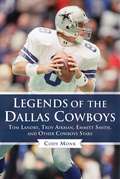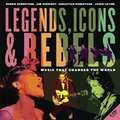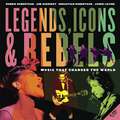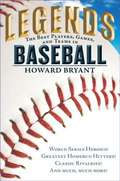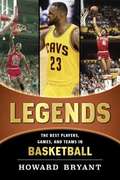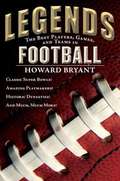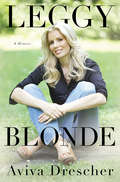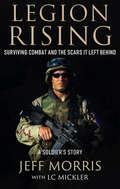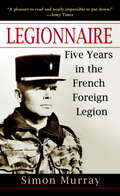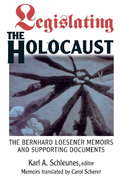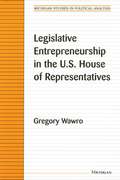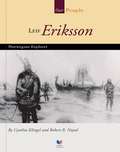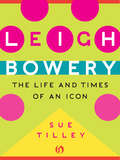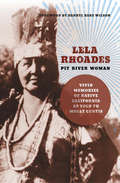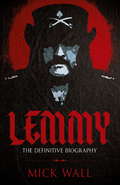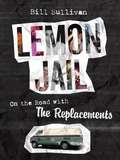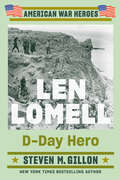- Table View
- List View
Legends of the Dallas Cowboys: Tom Landry, Troy Aikman, Emmitt Smith, and Other Cowboys Stars (Legends of the Team)
by Cody MonkFive Super Bowl titles, fifteen Hall of Famers, and a litany of legendary players, characters, and games later, the Dallas Cowboys franchise has cemented itself among the most successful in all of sports and, with a fan base that extends all over the world, among the most well known.Legends of the Dallas Cowboys takes an in-depth look at some of the legends who have shaped the Cowboys’ identity, beginning with Tom Landry, the man who was hired before Murchison had been awarded a team and who is still the franchise’s enduring image. Also included is Tex Schramm, under whom the Cowboys had twentystraight winning seasons and who is considered the most forward-thinking NFL executive ever, as well as Randy White, Ed “Too Tall” Jones, Bob Lilly, Lee Roy Jordan, Mel Renfro, and more. Also included are innovators such as Bob Hayes, who forced the creation of the zone defense, and Michael Irvin and Thomas “Hollywood” Henderson, who forced the creation of behavioral clauses in contracts. Each of the legends played his own unique role in shaping the lore of one of sports’ greatest franchises, a franchise that began humbly on a winter day in Miami and is now a model of success.
Legends of the Security Services Industry: Profiles in Leadership
by Keith Oringer Michael HymansonThe global contract security market now totals over $200 billion, with the number of private security officers exceeding that of public law enforcement officers. But this wasn’t always the case.Legends of the Security Services Industry: Profiles in Leadership presents the unique stories of 15 industry legends, who transformed the industry from early private detective and small night watch companies into large-scale contract security companies. The large-scale companies include, but are not limited to, Pinkerton, Burns International, The Wackenhut Corporation, Guardsmark, Wells Fargo, and U.S. Security Associates; as well as today’s leading security companies, Allied Universal, Securitas, G4S, Prosegur, and GardaWorld.The book begins in the nineteenth century, with early U.S. legendary detectives: Allan Pinkerton and William Burns. Then, the book focuses largely from the mid-twentieth century to the present, where successive generations of legends built large-scale contract security companies which competed with, and then acquired, those formed by the early legends. Part II legends George Wackenhut, Ira Lipman, and Tom Wathen; Part III legends, Charles Schneider, Kenneth W. Oringer, William Whitmore, Jr., and Albert Berger; and Part IV, Scandinavian legends Jørgen Philip-Sørensen, Lars Nørby Johansen, and Thomas Berglund, all developed major security companies. Part V includes current global security leaders Helena Revoredo Gut, Stephan Crétier, and Steve Jones. Part VI reviews the timelines and successful leadership of these legendary leaders, with a look at the future of the industry.The legends’ personal stories contain colorful insight into how they capitalized on the industry’s explosive growth. While each generation of legends faced unique social and competitive landscapes, their personal stories illustrate how they respectively succeeded. Their leadership and management prowess enabled them to achieve great success, as they displayed vision and achieved their goals through grit, determination, hard work, charisma, organizational skills, and calculated risk-taking.Each chapter has been extensively researched and includes firsthand accounts based on interviews with living legends, colleagues, and family of deceased legends. Personal, company and signature event photos add further color to the moving narrative. Their stories are not only highly interesting, but also provide a framework for current leaders, and the next generation of entrepreneurs, on how to build and lead large-scale security service companies. With a Foreword from Robert D. McCrie, PhD, longtime John Jay Professor and editor of the renowned industry publication The Security Letter.
Legends, Icons & Rebels: Music That Changed the World
by Robbie Robertson Jim Guerinot Sebastian Robertson Jared LevineMusic industry veterans Robbie Robertson, Jim Guerinot, Jared Levine, and Sebastian Robertson invite young readers to share with them in celebrating twenty-seven musical legends. Short profiles chronicle personal stories and achievements of extraordinarily talented artists whose innovations changed the landscape of music for generations to come. Compiled like any great playlist, the line-up features originators, rebels, and risk-takers across diverse genres. From Ray Charles to Johnny Cash, Chuck Berry to Bob Dylan, Robertson shares anecdotes about these artists and the influence they had on his own musical journey.
Legends, Icons & Rebels: Music That Changed the World
by Robbie Robertson Jim Guerinot Sebastian Robertson Jared LevineExclusive insights from a celebrated musician and passionate industry insiders, two accompanying CDs of legendary tracks and beautiful packaging make for a book with broad appeal -- one that will captivate fans of Robbie Robertson and music lovers of all ages.Part memoir, part tribute, and all great storytelling ...Music industry veterans Robbie Robertson, Jim Guerinot, Jared Levine, and Sebastian Robertson invite young readers to share with them in celebrating twenty-seven musical legends. Short profiles chronicle personal stories and achievements of extraordinarily talented artists whose innovations changed the landscape of music for generations to come. Carefully compiled like any great playlist, the line-up features originators, rebels, and risk-takers across diverse genres. From Ray Charles to Johnny Cash, Chuck Berry to Bob Dylan, Robertson shares anecdotes about these artists and the influence they had on his own musical journey.Always respectful of their reader, the writers never shy away from speaking about the difficult challenges these recording artists faced and the very human foibles that sometimes led to their tragic end. Most of all, it's the authors' passion and insights into these personal stories of creativity and collaboration -- and the power of music to shine a light on injustice and foster change -- that will fascinate, enlighten, and inspire music fans of all ages.&”Exclusive insights from a celebrated musician and passionate industry insiders, two accompanying CDs of legendary tracks and beautiful packaging make for a book with broad appeal -- one that will captivate fans of Robbie Robertson and music lovers of all ages.Tracklist for Legends, Icons & RebelsDisc One1. Chuck Berry Johnny B. Goode2. Johnny Cash Get Rhythm3. Aretha Franklin I Say a Little Prayer4. The Beatles Here Comes the Sun6. Bob Marley Three Little Birds5. Louis Armstrong What a Wonderful World7. Buddy Holly Peggy Sue8. Joni Mitchell The Circle Game9. Ray Charles & The Raelettes Hit the Road Jack10. Elvis Presley Hound Dog11. Curtis Mayfield & The Impressions People Get Ready12. Billie Holiday & Her Orchestra Let&’s Call the Whole Thing OffDisc Two 1. Little Richard Lucille2. Hank Williams Jambalaya (On the Bayou)3. Frank Sinatra Fly Me to the Moon4. Marvin Gaye I Heard It Through the Grapevine6. Sam Cooke Wonderful World5. Carole King So Far Away7. Louis Jordan Caldonia8. The Beach Boys In My Room9. Ella Fitzgerald A-Tisket, A-Tasket10. James Brown I Got You (I Feel Good)11. Patsy Cline Crazy12. Otis Redding That&’s How Strong My Love Is13. Nat King Cole It&’s Only a Paper Moon14. Stevie Wonder Signed, Sealed, Delivered I&’m Yours15. Bob Dylan Forever Young
Legends: The Best Players, Games, and Teams in Baseball
by Howard BryantExperience baseball's most exciting moments, World Series heroics, greatest players, and more! Baseball, America's pastime, is a sport of moments that stand the test of time. It is equally a sport of a new generation of heroes, whose exploits inspire today's young fans. This combination makes for a winning debut in Legends: The Best Players, Games, and Teams in Baseball. This is no traditional almanac of mundane statistics, but rather a storyteller's journey through baseball's storied game. Told in fun, accessible chapters and accompanied by iconic photos, a slew of Top Ten lists for kids to chew on and debate, and a Timeline of the 40 Most Important Moments in Baseball History, this collection covers some of the greatest players from Babe Ruth to Hank Aaron; the greatest teams to take the field and swing the bats; the greatest social triggers, such as Jackie Robinson's breaking of the color barrier; the greatest playoff rivalries, including the 2004 showdown between the Red Sox and Yankees that turned into an instant classic; and, of course, the edge-of-your-seat World Series moments that left some cheering while others wept. This is the perfect book for young fans eager to learn more about the sport that will stay with them for a lifetime.
Legends: The Best Players, Games, and Teams in Basketball
by Howard BryantFrom Magic Johnson to Michael Jordan to LeBron James to Steph Curry, ESPN's Howard Bryant presents the best from the hardwood--a collection of NBA champions and superstars for young sports fans! Fast-paced, adrenaline-filled, and brimming with out-of-this-world athleticism, basketball has won the hearts of fans all across America—yet it is particularly popular among kids and teens. Giants of the game like Steph Curry, LeBron, and Michael Jordan have transcended the sport to become cultural icons and role models to young fans. From the cornfields of Indiana and the hills of North Carolina, to the urban sprawl of New York City, Chicago and L.A., love of the game stretches from coast to coast. Featuring Top Ten Lists to chew on and debate, and a Top 40-style Timeline of Key Moments in Basektball History, this comprehensive collection includes the greatest dynasties, from the Bill Russell-era Celtics, to the Magic Jonson-led Lakers, to the Jordan-led Bulls, right up to the Tim Duncan-led Spurs. All the greats take flight toward the hoop in this perfect book for young fans who dream about stepping on an NBA court."A trove of awesome athletic feats, game-changing stars of the past and present, and rich fodder for heated arguments."--Booklist"Hoops fans will find a goldmine of information guaranteed to deepen their basketball knowledge and their understanding of the game."--VOYA
Legends: The Best Players, Games, and Teams in Football
by Howard Bryant"With the LEGENDS series, Howard Bryant brings to life the best that sports has to offer--the heroes, the bitter rivalries, the moments that every sports-loving kid should know."--Mike Lupica, #1 bestselling author of Travel Team, Heat, and Fantasy League In the second book of the LEGENDS series, ESPN's Howard Bryant delivers THE gridiron guide to most exciting event in sports: the Super Bowl! In this day and age, the gridiron reigns supreme. Football is America's most popular sport and the NFL's star players are instant celebrities with die-hard fans who live and die with each win or loss. And our collective obsession with the game begins when we're just kids and culminates each year on what has become the equivalent of a national holiday--Super Bowl Sunday. Recounting momentous stories of football's past and present, and accompanied by iconic photos, Top Ten Lists to chew on and debate, and a Top 40-style Timeline of Key Moments, this comprehensive collection details twenty of the greatest Super Bowls in NFL history--and expands on their relevance within the larger scope of dynasties, giants of the coaching world, and marquee players making history. From the upsets to the blowouts to the nail-biting finishes, this is the perfect book for young fans eager to kick off their football schooling.
Leggy Blonde: A memoir
by Aviva DrescherFor the first time ever, Aviva Drescher, the breakout star of The Real Housewives of New York City, shares her story in this tell-all memoir. <P><P>The only "born and bred New Yorker" in the history of the five seasons of The Real Housewives of New York, Aviva Drescher is elegant, sophisticated, extremely well educated and drop-dead gorgeous at 5'10". Her father, a self-proclaimed sex addict at age eighty, had a high-profile job managing everyone's money in the 1960s and 1970s--the Beatles, the Stones--so she had an interesting, privileged Manhattan lifestyle growing up, and now, she shares her life story in candid detail. <P><P> But Aviva's life hasn't always been glamorous: At just six years-old, she was in a farm accident when her foot got severely hurt at a friend's upstate New York dairy farm. A few months later her leg was amputated as a result of that accident. Aviva has never let this tragedy define who she is. Aviva attended New York's The Fieldston School as a child and went on to earn a Bachelors of Arts degree from Vassar College, a Masters in French Literature from New York University and law degree from The Benjamin N. Cardozo School of Law. At a chance meeting at Bed Bath & Beyond Aviva, a single mother at the time, met investment banker Reid Drescher as their young children played together in the aisles. It was only a matter of time before the two got married and grew their family together. <P><P> The Dreschers now have the quintessential contemporary modern family with four children--ranging in age from eleven to two years old. Honest and forthcoming, this part-time socialite and full-time mother gives us glimpse at her life in the limelight, and shows that she will let nothing hold her back from happiness and success.
Legion Rising: Surviving Combat and the Scars It Left Behind
by Jeff Morris LC MicklerA U.S. Army Platoon Leader shares an honest account of Iraq War combat and his long journey of healing from trauma in this military memoir. During his time in Iraq, Jeff Morris saw and experienced some truly harrowing events, such as the time he had to pulled shards of another man's skull from the palm of his hand. When he got home, he struggled for years just to face his own reflection. In Legion Rising, Morris provides a candid account of his service—from the rigors of military training through the thrills, dangers, and tragedies of combat. Morris tells of losing eight men in the line of duty, and of the second battle he faced once his combat service was over. Scarred by trauma and haunted by the past, Morris faced a long struggle before his ultimate rise from adversity.
Legionnaire: Five Years in the French Foreign Legion
by Simon MurraySimon Murray was nineteen when he joined the French Foreign Legion. Inspired by the romantic myths of Beau Geste, he found himself in the ranks of one of the world's greatest - and toughest - fighting forces. He kept a unique diary of the hard living, harsh discipline, and the military tradition of 'March or Die' which he turned into this gripping book. 'Simon Murray's personal account of a gently reared, well-educated British youth's coming of age in the French Foreign Legion has the drama, excitement and colour of a good guts-and-glory thriller ... Murray is a talented storyteller, and his fellow legionnaires and their disciplined and proud Corps are vividly portrayed. I was hooked from the first page.' Dr. Henry Kissinger. 'One of the greatest adventure stories in recent years.' Chris Patten.
Legislating the Holocaust: The Bernhard Loesener Memoirs and Supporting Documents
by Karl A. SchleunesFrom April 1933 to early 1943, Bernard Loesener served as the official "Jewish Expert" in the German Third Reich's Ministry of the Interior, the government body responsible for the Nazi's legislative assault on German Jewry. In that role, he personally drafted much of the legislation, the Nuremberg Laws of 1935 preeminently, that gradually dispossessed, disenfranchised, and dehumanized the Jews of Nazi Germany. During the first six years of Nazi rule, the seminal period of government-sponsored anti-Semitism, Loesener kept the minutes of many crucial, high-level, inter-ministerial conferences concerned with the "Jewish Question. " As observer and participant, his experiences were virtually unparalleled. In 1950, Loesener penned a memoir that sought to explain, and justify, his actions during the ten-year escalation of Nazi oppression that resulted, to Loesener's professed horror, in the Final Solution. It was published in 1961, in German, by the journal Vierteljahrshefte fuer Zeitgeschichte. It has never before appeared in English, until now - in Legislating the Holocaust.
Legislative Entrepreneurship in the U.S. House of Representatives
by Gregory WawroWhen members are elected to the House of Representatives they have a certain freedom to decide how they will act as members and how they will build their reputations. Just as in the market place entrepreneurs build businesses, so in the House of Representatives members have the freedom to choose to build legislative programs that will enhance their reputations in the institution. And yet entrepreneurship is also costly to members. Gregory Wawro explains why members of the House engage in legislative entrepreneurship by examining what motivates them to acquire policy knowledge, draft legislation, build coalitions, and push their legislation in the House. He considers what incentives members have to perform what many have perceived to be the difficult and unrewarding tasks of legislating. This book shows how becoming a legislative entrepreneur relates to members' goals of reelection, enacting good public policy, and obtaining influence in the House. The analysis differs from previous studies of this behavior, which for the most part have employed case study methods and have relied on anecdotal evidence to support their arguments. Wawro analyzes legislative entrepreneurship in a general and systematic fashion, developing hypotheses from rational-choice-based theories and testing these hypotheses using quantitative methods. Wawro argues that members engage in legislative entrepreneurship in order to get ahead within the House. He finds that the more legislative entrepreneurship that members engage in, the more likely it is that they will advance to prestigious positions. This book is of interest to students of Congress, legislative behavior and institutions, elections, and campaign finance. Gregory Wawro is Assistant Professor of Political Science, Columbia University.
Legitimate Kid \ Hija legítima (Spanish edition): Una vida entre el dolor y la risa
by Aida RodriguezUn divertido y conmovedor libro de memorias en ensayo de la comediante Aida Rodríguez sobre el poder de superar las dificultades y transformar el dolor en risa. Aida Rodríguez ha vivido, por decir poco, una vida de torbellino. La historia de cómo pasó de la pobreza a la opulencia es alucinante: cuando era niña, su madre la secuestró y se la llevó de la República Dominicana a los Estados Unidos. Más tarde, un nuevo secuestro, esta vez a manos de su abuela y su tío, la dejó en Florida. Ya de adulta, escapó de un matrimonio tormentoso y terminó, junto con sus hijos, mendigando por las calles de Los Ángeles. Durante todas esas adversidades, Aida nunca perdió su sentido del humor. Nacida con un maravilloso ingenio y un espíritu irrefrenable, Aida ha utilizado su talento y trabajado sin descanso para convertir la tragedia y el dolor en una comedia mordaz que abarca todo, desde la misoginia y el racismo hasta las redes sociales y los titulares de prensa. Con el tiempo, lanzó un exitoso especial en HOB Max que la llevó a múltiples acuerdos de desarrollo, un logro que le ganó una audiencia nacional, le abrió puertas y la ayudó expandir la forma en que los latinos están representados en la comedia. En este, su tan esperado primer libro, Aida dibuja sus muchos altibajos. Desde los contratiempos personales hasta los éxitos profesionales, Hija legítima es entrañable, impactante y, en última instancia, vivificante. A hilarious and heartbreaking memoir-in-essays from comic Aida Rodriguez on the power of overcoming hardship and transforming pain into laughter.Aida Rodriguez has, to put it mildly, lived a whirlwind life. Her rags to-riches story is mind-blowing: She was kidnapped as a child by her mother in the Dominican Republic and brought to the US. She was later kidnapped again by her grandmother and uncle, and moved from New York to Florida. As an adult, she ended a difficult marriage and endured homelessness with her children in Los Angeles. But through it all she never lost her sense of humor.Born with a wonderful wit and an irrepressible spirit, Aida used her gifts and worked tirelessly, turning tragedy and pain into biting comedy that takes on everything from misogyny and racism to social media and news headlines. She eventually released a hit HBO Max special which led to multiple development deals—success that won her a nationwide audience, opened doors, and helped her expand the way Latinos are represented in comedy.In this, her highly anticipated first book, Aida charts her many ups and downs. From personal setbacks to career highs and everything in between, Legitimate Kid is endearing, shocking, and ultimately life-affirming.
Legitimate Kid: A Memoir
by Aida RodriguezLegitimate Kid has descriptive copy which is not yet available from the Publisher.
Leibniz
by Maria Rosa AntognazzaOf all the thinkers of the century of genius that inaugurated modern philosophy, none lived an intellectual life more rich and varied than Gottfried Wilhelm Leibniz (1646-1716). Trained as a jurist and employed as a counsellor, librarian, and historian, he made famous contributions to logic, mathematics, physics, and metaphysics, yet viewed his own aspirations as ultimately ethical and theological, and married these theoretical concerns with politics, diplomacy, and an equally broad range of practical reforms: juridical, economic, administrative, technological, medical, and ecclesiastical. Maria Rosa Antognazza's pioneering biography not only surveys the full breadth and depth of these theoretical interests and practical activities, it also weaves them together for the first time into a unified portrait of this unique thinker and the world from which he came. At the centre of the huge range of Leibniz's apparently miscellaneous endeavours, Antognazza reveals a single master project lending unity to his extraordinarily multifaceted life's work. Throughout the vicissitudes of his long life, Leibniz tenaciously pursued the dream of a systematic reform and advancement of all the sciences, to be undertaken as a collaborative enterprise supported by an enlightened ruler; these theoretical pursuits were in turn ultimately grounded in a practical goal: the improvement of the human condition and thereby the celebration of the glory of God in His creation. As well as tracing the threads of continuity that bound these theoretical and practical activities to this all-embracing plan, this illuminating study also traces these threads back into the intellectual traditions of the Holy Roman Empire in which Leibniz lived and throughout the broader intellectual networks that linked him to patrons in countries as distant as Russia and to correspondents as far afield as China.
Leibniz in His World: The Making of a Savant
by Audrey BorowskiA sweeping intellectual biography that restores the Enlightenment polymath to the intellectual, scientific, and courtly worlds that shaped his early life and thoughtDescribed by Voltaire as &“perhaps a man of the most universal learning in Europe,&” Gottfried Wilhelm Leibniz (1646–1716) is often portrayed as a rationalist and philosopher who was wholly detached from the worldly concerns of his fellow men. Leibniz in His World provides a groundbreaking reassessment of Leibniz, telling the story of his trials and tribulations as an aspiring scientist and courtier navigating the learned and courtly circles of early modern Europe and the Republic of Letters.Drawing on extensive correspondence by Leibniz and many leading figures of the age, Audrey Borowski paints a nuanced portrait of Leibniz in the 1670s, during his &“Paris sojourn&” as a young diplomat and in Germany at the court of Duke Johann Friedrich of Hanover. She challenges the image of Leibniz as an isolated genius, revealing instead a man of multiple identities whose thought was shaped by a deep engagement with the social and intellectual milieus of his time. Borowski shows us Leibniz as he was known to his contemporaries, enabling us to rediscover him as an enigmatic young man who was complex and all too human.An exhilarating work of scholarship, Leibniz in His World demonstrates how this uncommon intellect, torn between his ideals and the necessity to work for absolutist states, struggled to make a name for himself during his formative years.
Leicester City: The Inside Story of England's Most Unlikely Champions
by Gordon Taylor Harry Harris Richard BevanThe Immortals is the fairy-tale account of Leicester City, who rose from the very bottom of the English Premier League-the world’s toughest soccer league-to triumph against all odds (5,000-1) and finish as champions.Ending up in League One (third level) for the first time in 2008-09, the team stormed through the season to win the league and was promoted back up to the League Championship (second league). After four seasons as a middle-of-the-pack team, Leicester won the league in 2013-14, being promoted to the EPL for the first time in a decade. After a strong start the following season, the team quickly faded and looked to be facing relegation. But after winning seven out of their last nine games, they avoided the demotion and finished in fourteenth place.Under the calm and wise management of Claudio Ranieri-who was named as manager to start the 2015-16 season-the East Midlands club stunned football supporters by winning despite not having a recognizable superstar on the team.With massive team spirit and a never-say-die attitude, the team kept Tottenham, Arsenal, and Manchester City at bay to secure their first ever Premier League trophy in their 132-year history. In the process, journeyman players such as Jamie Vardy, Riyad Mahrez, N’Golo Kante, and Kasper Schmeichel became household names and added to the team’s growing lore.Written by legendary soccer writer Harry Harris, with seventy-six books to his name, The Immortals is a must-read for all fans of the sport, as well as those who adopted Leicester City and the Foxes during their dramatic run.
Leif Eriksson: Norwegian Explorer
by Cynthia Klingel Robert B. Noyed Cynthia Fitterer KlingelA biography of Leif Eriksson: Norwegian Explorer
Leif The Lucky
by Ingri Daulaire Edgar P. DaulaireA biography of Leif Erickson, son of Eric the Red,a famous Viking and early visitor to North America.
Leigh Bowery
by Sue TilleyThe definitive biography of one of modern art's most provocative vanguards Leigh Bowery was one of the most controversial and avant-garde performers of his generation. In this fascinating biography, author Sue Tilley, one of Bowery's closest friends, lays bare the extravagant life of the trendsetting entertainer. From Bowery's groundbreaking costumes and performance art, to his notoriety in London's 1980s nightclub culture, to his role as a favored model for painter Lucian Freud, Tilley's engrossing portrait offers insight into the outrageous world of 1980s modern art and the man who came to embody it. This ebook features a new postscript by Sue Tilley and an illustrated biography including rare photos from the author's personal collection.
Lela Rhoades: Pit River Woman
by Molly CurtisLela Rhoades has a voice so sharp, so funny, warm, and honest, that the stories of her life and the traditions of her parents will barely sit still on the page. As told to Molly Curtis in the 1970's, this memoir takes us back into a world where men chased mother grizzlies out of their dens for their meat, where manzanita berries were ground up into sugar and houses built with the door right in the middle of the roof. It was an intricate, complex life that was unknown to the strangers that would take over the land. <P><P>For all of her recollections, old recipes, and legends, this is also a story of transition for Lela Rhoades, her Achumawi people, and for Native California in general. Here, Rhoades walks the line between tradition and change, watching the land and hunting rights of her people vanish, telling creation stories that blend both Coyote and Jesus, and recounting her marriage to a white rancher. Come, sit down at the feet of Lela Rhoades, and listen to the strength and beauty of her world.
Lemmy: The Definitive Biography
by Mick Wall'Unflinching, forthright and full of wry humour as the man himself, and there's little praise greater than that' CLASSIC ROCK'Wall's vision of Lemmy as a Rock'n'Roll stalwart who made no concessions is vivid to the last' GUARDIANIn 'The Ace of Spades', Motörhead's most famous song, Lemmy, the born-to-lose, live-to-win frontman of the band sang, 'I don't want to live forever'. Yet as he told his friend of 35 years, former PR and biographer Mick Wall, 'Actually, I want to go the day before forever. To avoid the rush...'. This is his strange but true story. Brutally frank, painfully funny, wincingly sad, and always beautifully told, LEMMY: THE DEFINITIVE BIOGRAPHY is the story of the only rock'n'roller never to sell his soul for silver and gold, while keeping the devil, as he put it, 'very close to my side'. From school days growing up in North Wales, to first finding fame in the mid-60s with the Rockin' Vicars; from being Jimi Hendrix's personal roadie ('I would score acid for him'), to leading Hawkwind to the top of the charts in 1972 with 'Silver Machine' ('I was fired for taking the wrong drugs'); from forming Motörhead ('I wanted to call the band Bastard but my manager wouldn't let me'), whose iconoclastic album NO SLEEP 'TIL HAMMERSMITH entered the UK charts at No. 1.Based on Mick's original interviews with Lemmy conducted over numerous years, along with the insights of those who knew him best - former band mates, friends, managers, fellow artists and record business insiders - this is an unputdownable story of one of Britain's greatest characters. As Lemmy once said of Wall, 'Mick Wall is one of the few rock writers in the world who can actually write and seems to know anything about rock music. I can and do talk to him for hours - poor bastard.' With the hard part of his journey now over, Lemmy is set to become a legend. LEMMY: THE DEFINITIVE BIOGRAPHY explains exactly how that came to be.
Lemmy: The Definitive Biography
by Mick WallBrutally frank, painfully funny, wincingly sad, and always beautifully told, LEMMY: THE DEFINITIVE BIOGRAPHY is the story of the only rock'n'roller never to sell his soul for silver and gold, while keeping the devil, as he put it, 'very close to my side'. From school days growing up in North Wales, to first finding fame in the mid-60s with the Rockin' Vicars; from being Jimi Hendrix's personal roadie, to leading Hawkwind to the top of the charts in 1972 with 'Silver Machine; to forming Motörhead. Based on Mick's original interviews with Lemmy conducted over numerous years, along with the insights of those who knew him best - former band mates, friends, managers, fellow artists and record business insiders - this is a compelling story of one of Britain's greatest characters. As Lemmy once said of Wall, 'Mick Wall is one of the few rock writers in the world who can actually write and seems to know anything about rock music. I can and do talk to him for hours"
Lemon Jail: On the Road with the Replacements
by Bill SullivanA tour diary of life on the road with one of Minnesota&’s greatest bands—with nearly 100 never-before-seen photographs &“Don&’t bore us, get to the chorus&” is Bill Sullivan&’s motto, which will come as no surprise to anyone who opens Lemon Jail. A raucous tour diary of rock &’n&’ roll in the 1980s, Sullivan&’s book puts us in the van with the Replacements in the early years. Barreling down the highway to the next show through quiet nights and hightailing it out of scandalized college towns, Sullivan—the young and reckless roadie—is in the middle of the joy and chaos, trying to get the band on stage and the crowd off it and knowing when to jump in and cover Alice Cooper. Lemon Jail shows what it&’s like to keep the band on the road and the wheels on the van—and when to just close your eyes and hit the gas. That first van, dubbed the Lemon Jail by Bill, takes the now legendary Replacements from a south Minneapolis basement to dive bars and iconic rock clubs to college parties and eventually an international stage. It&’s not a straight shot or a smooth ride, and there&’s never a dull moment, whether Bob Stinson is setting a record for the quickest ejection from CBGB in NYC or hiding White Castle sliders around a hotel room or whether Paul Westerberg is sneaking gear out of a hostile venue or saving Bill&’s life at a brothel in New Jersey. With growing fame (and new vans) come tours with REM and X (what happens when the audience isn&’t allowed to stand?), Tom Petty and the Heartbreakers and the Violent Femmes (against their will), and Saturday Night Live, where the band&’s televised antics earn the edict You&’ll never play on NBC again. Fast forward: You&’ll never play Washington, D.C., again. Or Moorhead.Hiding in fans&’ backyards while the police search the streets and pelted with canned goods at a Kent State food drive, the Replacements hit rough patches along with sweet spots, and Lemon Jail reveals the grit and glory both onstage and off, all told in the irrepressible, full-throttle style that makes Bill Sullivan an irresistible guide on this once-in-a-lifetime road trip with a band on the make.
Len Lomell: D-Day Hero (American War Heroes)
by Steven M. GillonThe exhilarating, inspiring story of Len Lomell, an Army Ranger who on D-Day almost single-handedly knocked out the big German guns before they could fire on the American invasion force, and whose later exploits spanned the most dramatic battles of World War II. Len Lomell was drafted to the United States Army in 1942, became an Army Ranger, and was soon sent to England to prepare for the D-Day invasion. At Point du Hoc, Lomell and his men were given a daunting mission—to scale the steep cliffs and disable the big German guns at the top, guns that could otherwise destroy the rest of the D-Day landing fleet. Despite incredible odds, it was a mission that Lomell completed almost single-handedly. In this stirring, action-packed book, Gillon details the incredibly heroic actions on D-Day—and throughout World War II—that ultimately won Lomell the Distinguished Service Cross, a Silver Star, and a Bronze Star. Lomell was later praised by Stephen Ambrose as the single most important person in the success of D-Day after General Eisenhower. With propulsive writing, nuanced research, and multiple personal interviews with Lomell, Gillon brings an unforgettable WWII hero to life, finally giving him the recognition he so richly deserves.
